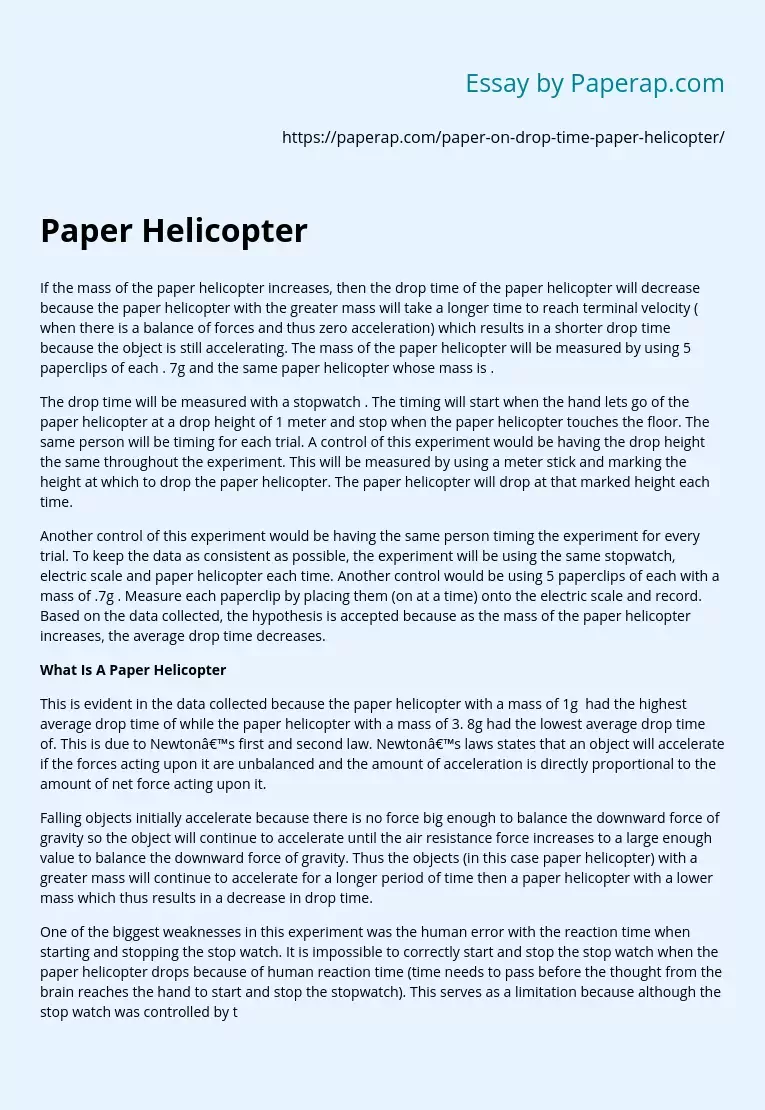What Is A Paper Helicopter
If the mass of the paper helicopter increases, then the drop time of the paper helicopter will decrease because the paper helicopter with the greater mass will take a longer time to reach terminal velocity ( when there is a balance of forces and thus zero acceleration) which results in a shorter drop time because the object is still accelerating. The mass of the paper helicopter will be measured by using 5 paperclips of each . 7g and the same paper helicopter whose mass is .
The drop time will be measured with a stopwatch . The timing will start when the hand lets go of the paper helicopter at a drop height of 1 meter and stop when the paper helicopter touches the floor. The same person will be timing for each trial. A control of this experiment would be having the drop height the same throughout the experiment. This will be measured by using a meter stick and marking the height at which to drop the paper helicopter.
The paper helicopter will drop at that marked height each time.
Another control of this experiment would be having the same person timing the experiment for every trial. To keep the data as consistent as possible, the experiment will be using the same stopwatch, electric scale and paper helicopter each time. Another control would be using 5 paperclips of each with a mass of .7g . Measure each paperclip by placing them (on at a time) onto the electric scale and record. Based on the data collected, the hypothesis is accepted because as the mass of the paper helicopter increases, the average drop time decreases.
This is evident in the data collected because the paper helicopter with a mass of 1g had the highest average drop time of while the paper helicopter with a mass of 3. 8g had the lowest average drop time of. This is due to Newton’s first and second law. Newton’s laws states that an object will accelerate if the forces acting upon it are unbalanced and the amount of acceleration is directly proportional to the amount of net force acting upon it.
Falling objects initially accelerate because there is no force big enough to balance the downward force of gravity so the object will continue to accelerate until the air resistance force increases to a large enough value to balance the downward force of gravity. Thus the objects (in this case paper helicopter) with a greater mass will continue to accelerate for a longer period of time then a paper helicopter with a lower mass which thus results in a decrease in drop time.
One of the biggest weaknesses in this experiment was the human error with the reaction time when starting and stopping the stop watch. It is impossible to correctly start and stop the stop watch when the paper helicopter drops because of human reaction time (time needs to pass before the thought from the brain reaches the hand to start and stop the stopwatch). This serves as a limitation because although the stop watch was controlled by the same person each time, a different time lapse will pass each time thus causing the inability to accurately time the helicopter drop each time.
Another weakness would be that since the person holding the paper helicopter each time has to move their hands, the angle at which the paper helicopter is dropped won’t be the same each time which results in a shorter or longer drop time if the paper helicopter lands closer or farther from where it was dropped. There are several ways to improve this investigation to make the data more accurate.
To decrease the lapse in stopping the stop watch, using a higher drop height would give the person timing more time to react to when the paper helicopter reaches the floor because the original procedure allowed (at max) 65 seconds to react from the time it took the paper helicopter to drop from the drop height to the floor. Another way to improve this investigation would be to create a stand that will hold the paper helicopter at the same drop height and angle each time so that the distance that the paper helicopter will land will be the same each time. This will reduce the error in time because of a shorter or longer landing distance.
What Is A Paper Helicopter. (2019, Dec 05). Retrieved from https://paperap.com/paper-on-drop-time-paper-helicopter/

